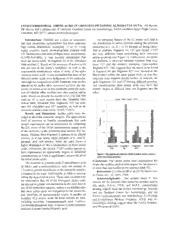
NASA Technical Reports Server (NTRS) 20110008083: Extraterrestrial Amino Acids in Ureilites Including Almahata Sitta PDF
Preview NASA Technical Reports Server (NTRS) 20110008083: Extraterrestrial Amino Acids in Ureilites Including Almahata Sitta
EXTRATERRESTRIAL AMINO ACIDS IN UREILITES INCLUDING ALMAHATTA SITTA. AS Burton, DP Glavin, MP Callahan and JP Dworkin.. Goddard Center for Astrobiology, NASA Goddard Space Flight Center, Greenbelt, MD 24771, aaron.s,[email protected] . Introduction: Ureilites are a class of meteorites An intriguing feature of the C, amino acid data is that lack ehondrules (achondrites) but have relatively the distribution of amine position among the different high carbon abundances, averaging —3 wt %. Using meteorites {i. e_. a, P, { or 5). Despite all being classi- highly sensitive liquid chromatography coupled with fied as ureilites, fragment #4, 427 and ALHA 77257 UV fluorescence and time-of-flight mass spectrometry are very different when considering their dominant (LC-FD/ToF-MS), it was recently determined that amine positions (see Figure 1). Furthermore, the great- there are amino acids in. fragment 94 of the Almahata est similarity is observed between Almhata Sitta frag- Sitta ureilite[l]. Based on the presence of amino acids ment 427 and the ordinary chondrite, (non-ureilite) that are rare in the Earth's biosphere, as well as the fragment 425. This suggests that the amino acids found near-raceic enantiomeric ratios of marry of the more in fragment 44 and fragment =27 were formed at dif- common amino acids, it was concluded that most of the ferent times within the same parent body, or that they detected amino acids were indigenous to the meteorite. originate from separate parent bodies. In contrast, de- Although the composition of the AI€mahata Sitta ureilite spite fragments 425 and 427 having different petrolog- appears to be unlike other recovered ureilites, the dis- ical classifications, their amino acids may have had covery of amino acids in this meteorite raises the ques- similar origins or diffused from one fragment into the tion of whether other ureilites rnav also contain arnino other. acids. Herein we present the results of LC-FDlTo.F-MS analyses of: a sand sample from the Almahata Sitta strewn held, Altnahata Sitta fragments 425 (an ordi- nary H5 ehondrite) and 427 (ureilite), as well as an Antarctic ureilite (Allan lulls, ALHA 77257). Results and Discussion: Amino acids were de- tected in all of the meteorite samples. The approximate level of exposure to Earthly contaminants that each sample experienced can be ascertained by comparing the D/1. ratios of the chiral proteinaceo s amino acids of the meteorite to the terrestrial sand sample. For ex- ample, Almhata Sitta fragment 4 appears to be almost pristine, as it has nearly equal amounts of L- and D- glutamuc acid and alanine, while the sand shows a higher abundance of the L-enantiomers of these amino acids. Conversely_ the ALI4r't 77257 ureilite appears to have experienced an appreciable degree of terrestrial contamination, as it has a significant L-excess for all of A function amine position the chiral amino acids. Conclusion: The varied amino acid compositions be- The 4-carbon (C4) amino acids 0-aminobutyric acid tween the urcilites studied here argues for the presence (3-ABA) and a-aminoisobutyric acid are present in of more than one ureilite in the asteroid 2008 TC3, 1.5-fold or greater abundances in the meteorite samples References: [ I ] Glavin DP et a] (2414) 44eteoritics compared to the sand. Additionally, 1-ABA is racemic & Planet. Sci., 45. t695--1709. within the measurement error. These data, coupled with Acknowledgments: The authors thank P. Jen- the observation that all of the biological amino acids niskens for the Almhata Sitta meteorite samples used in are present in greater concentrations in the sand than in this study. D.P.G, J.P.D, and M.P.C, acknowledge any of the meteorites samples, makes a compelling case funding support from the NASA Astrobiology Institute that these amino acids are indigenous to the meteorite, and the Goddard Center for Astrobiology, and the and, therefore, of extraterrestrial origin. A number of NASA Cosmochernistry and Astrobiology: Exobiology 5-carbon (C,) amino acids fit these criteria as well, and Evolutionary Biology Programs. A.S.B. also ac- including isovaline, 3-aminopentanoic acid, 3-amino- knowledges funding support from the NASA Postdoc- 2.2-dimethylpropa oic acid, 4-amino-2-methyibutanoic toral Program at GSFC. acid and 4-amino-3methylbutanoic acid.
